The Nikon Nikkor Z 70-200mm F2.8 VR S is the first of its type for Nikon’s Z series full-frame mirrorless cameras. As an f/2.8 S-type intended for pros and serious amateurs, it features a better build and a high-grade optical system that’s not so dependent on built-in profile corrections as the f/4 S-type models.
It also has slightly different cosmetics and features, including a small OLED panel that can display aperture or focal length, as well as the option to display focus distance with a depth-of-field scale below. It also has a customizable control ring and separate focusing collar.
The stabilized lens has a complex optical design consisting of 21 elements arranged in 18 groups and includes no fewer than six ED (extra-low dispersion) elements, one fluorite (FL) element, and a shortwave refractive (SR) element to help mitigate chromatic aberration. There are also Arneo and Nano Crystal coatings to improve ghosting and flare, as well as a fluorine coating to help when cleaning the front element.
Autofocus uses twin stepper motors for control of more than focus group and provides smooth, quiet focusing down to just 0.5 m (1.64 ft) at 70 mm, albeit increasing to 1.0 m (3.28 ft) at 200 mm.
You can view the results for all tested lenses and create your own comparisons and in-depth analyses using our interactive image lens comparison tool.
Key specifications:
- 21 elements in 18 groups
- Six ED elements, one FL and one SR element
- Optical image stabilization
- Nine-blade rounded aperture
- Twin AF stepper motors
- Dust- and moisture-resistant
- 77 mm filter thread
- Minimum focus distance: 0.5 m (1.64 ft) to 1.0 m (3.28 ft)
- Weight: 1360 grams (2.99 lb)
Test results
We tested the Nikon Nikkor Z 70-200mm F2.8 VR S on the Nikon Z7, where the camera with its high-resolution 47 MP sensor and lens together as a “system result” achieved a DXOMARK score of 38. Note that using other camera bodies (where tested) will affect the overall result. It’s the second-best-performing 70-200 mm f/2.8 model in our database, with just one point separating it from the Sony FE 70-200mm F2.8 GM OSS — meaning that they’re very closely matched despite different optical characteristics.
This new lens has very high and consistent sharpness across the field (that is, from the center out to the edges and corners) at almost every aperture, except at f/22, where the effects of diffraction on sharpness levels are especially noticeable. One highlight of the new Nikkor is excellent sharpness wide-open at f/2.8 at all focal lengths, even at the longest, where tele-zoom lenses tend to lose some sharpness.
Geometric distortion is very low at the shorter end, with some pincushion starting at around the 105 mm mark that increases slowly up to 200 mm. Vignetting is generally quite well controlled throughout except at the initial aperture at 105 mm and longer, though the effects are soon mitigated somewhat by stopping down. It also has good and highly consistent transmission, measured at 3.1 TStop, throughout the focal range
The new Nikkor Z lens also has very low levels of lateral chromatic aberration generally, and although it has slightly higher levels at 200 mm than at the other end of the zoom range, it’s still low.
Overall, this Nikon Nikkor Z 70-200mm F2.8 VR S is an outstandingly good performer. As always, though, it’s well worth looking through the more detailed data to see how the lens performs at individual aperture settings and at various focal lengths.
In-depth comparisons
We’ve compared the Nikon Nikkor Z 70-200mm F2.8 VR S with its rival, the 2016 FE 70-200mm F2.8 GM OSS model from Sony on the 45.7 MP Sony A7R II. Although we have compared (and you can also compare) its performance on the A7 RIV, the A7R II is an older model but is closest to the Nikon Z7 in pixel count. The reason for choosing this older body is that it’s easier to compare lens sharpness performance between manufacturers, which is affected by the sensor’s resolution.
We’ve also compared the Nikkor Z lens with the 2009 AF-S Nikkor 70-200mm F2.8 ED VR II on the Nikon D850, another model with a 47 MP sensor. While not the highly praised, fluorite-touting F-mount version from 2016, this ED VR II model was nonetheless highly acclaimed.
You can see an overview of this comparison in our database.
Sharpness
On telephoto zooms like this it’s not usual to see the sharpness drop towards the end of the zoom range, but the Nikkor Z bucks that trend and holds on to every pixel. Admittedly, there’s a slight drop in sharpness in the periphery at f/2.8, but you would be hard-put to notice. It’s not only sharp but very consistent right across the frame, with no real astigmatic-like aberrations to be seen, save for a slight amount at 135 mm and mostly at the initial aperture. Sharpness improves a little when stopped down as you might expect, but most of the improvement is in terms of consistency or uniformity across the frame. Edge-to-edge sharpness doesn’t get much better than this and it’s quite an improvement over the 2009 AF-S Nikkor 70-200mm F2.8 ED VR II. Mitigation of astigmatic behavior in the outer zones (where sharpness suffers in the older model) is another benefit of this newer design.
However, things are little different against the Sony FE 70-200mm F2.8 GM OSS. The Nikkor Z is evenly matched overall for the most part, though it is strongest is at the initial aperture, where it has slightly higher sharpness over the Sony throughout much of the focal range. While the Sony comes close at 200 mm, some non-uniform, astigmatic-type performance holds it back. When stopped down though, fortunes reverse, and it’s the Sony that’s slightly ahead.
Chromatic aberration
Lateral chromatic aberration, or lateral color, appears in the image plane as colored fringing on either side of high-contrast edges, and the effect extends progressively out to the edges and corners. While this is typically easy to remove with software, color fringing can reduce sharpness, so if price allows it’s always better to use high-grade optics to correct it in the first place. The Nikkor Z does extremely well in mitigating the effects at practically all apertures and focal lengths. If there’s some weakness compared to the two rivals, it’s at f/2.8 at 200 mm, where there are slightly higher levels mid-frame. While the Sony comes close, the Nikkor Z is the best of the three in controlling it overall, especially at the shorter focal lengths.
Geometric distortion
Like lateral chromatic aberration correction, control of distortion is best achieved optically, as using a profile or software to make corrections can stretch an image and lower the sharpness. To that end, the Nikkor Z performs well at the shorter focal lengths, with minimal barrel at 70 mm (measured at -0.1%); it is better corrected than the older F-mount Nikkor and substantially better than the Sony. However, this changes over to pincushion distortion quite quickly at 85 mm (measured at 0.2%) and continues to increase to 0.4 % at 105 mm and to 0.5% at 135 mm, which is slightly higher than both the older Nikkor and the Sony (measured at 0.3%). All three perform identically at 200 mm, where each model has relatively low levels of pincushion (measured at 0.6%).
Vignetting (corner shading)
Corner shading is highest in the Nikkor Z when wide-open at 200 mm and lowest at 70 mm, which is to be expected, and is the same for both the F-mount lens and the Sony. However, the best corrected overall is the F-mount, while the two mirrorless lenses perform quite similarly. Visually the effect is heaviest for the Nikkor Z at 200 mm, though between it and the Sony, the Nikkor Z has a larger brighter central core at f/2.8, though slightly darker edges. That said, it’s the Nikkor that clears up the quickest between the two mirrorless lenses, with all traces of shading disappearing by f/8.
Transmission
Transmission is a good measure of the effectiveness of the lens’s coatings, and it’s useful to know if you’re using your lenses for video. Furthermore, it can even vary between camera models, so it’s worth taking that into consideration. With zoom lenses, uneven transmission can alter brightness levels during a change in focal length, so keep an eye out in our results for large deviations in brightness throughout the zoom range. In this regard, the Nikkor Z is highly consistent from 70 mm all the way through to 200 mm, varying just 0.1 EV over the range. The Sony is similar in that respect, but it also has the highest transmission of the three, averaging T2.9, versus T3.1 for the Nikkor Z.
Conclusion
Over the years, 70-200 mm f/2.8 lenses have become one the most important products in a manufacturer’s lineup, as its performance is considered a barometer for the rest of the high-end lenses in the system. As such they’re regularly updated and feature the latest optical advances, so it’s unsurprising to see the Nikkor Z 70-200mm F2.8 VR S easily outperform the old 2009 AF-S Nikkor 70-200mm F2.8 ED VR II, which is now two generations behind. With the new SR element backing up the fluorite and ED elements, the new Nikkor Z 70-200mm F2.8 VR S is a great performer optically and is a fine addition to the Z system overall. If sports, wildlife, photojournalism, or even portraiture is your thing, it would make a great choice.
In this review, we have compared the Nikon Nikkor Z 70-200mm F2.8 VR S mounted on a Nikon Z7 to its closest rivals from other brands. Remember that the lenses may be used on various cameras with different sensors, or in some cases on different camera systems using different mounts, so the results will vary between them.
As usual, you can create your own comparisons and in-depth analyses using our interactive image lens comparison tool.


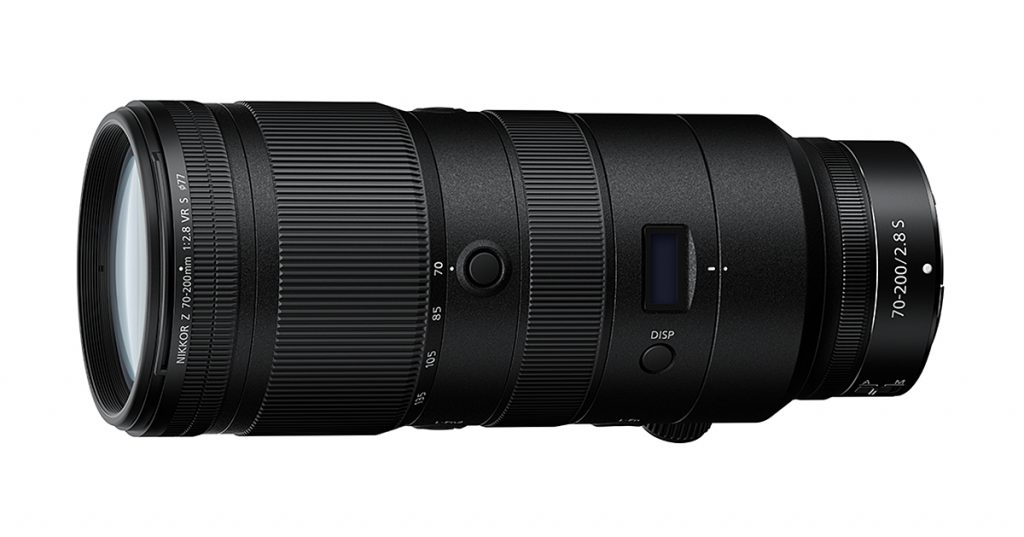


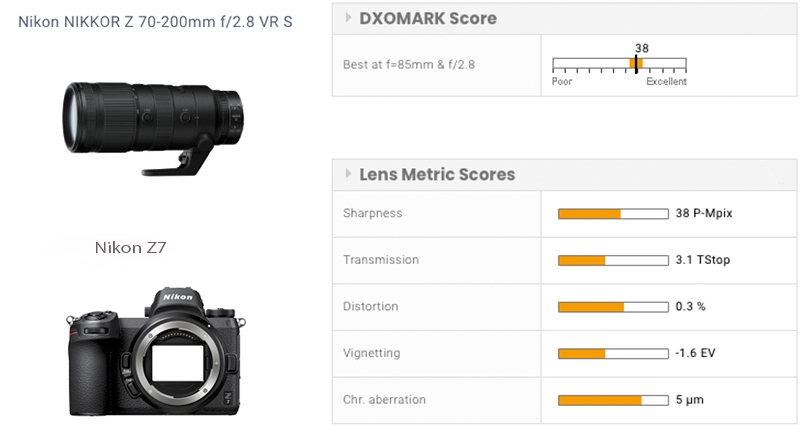
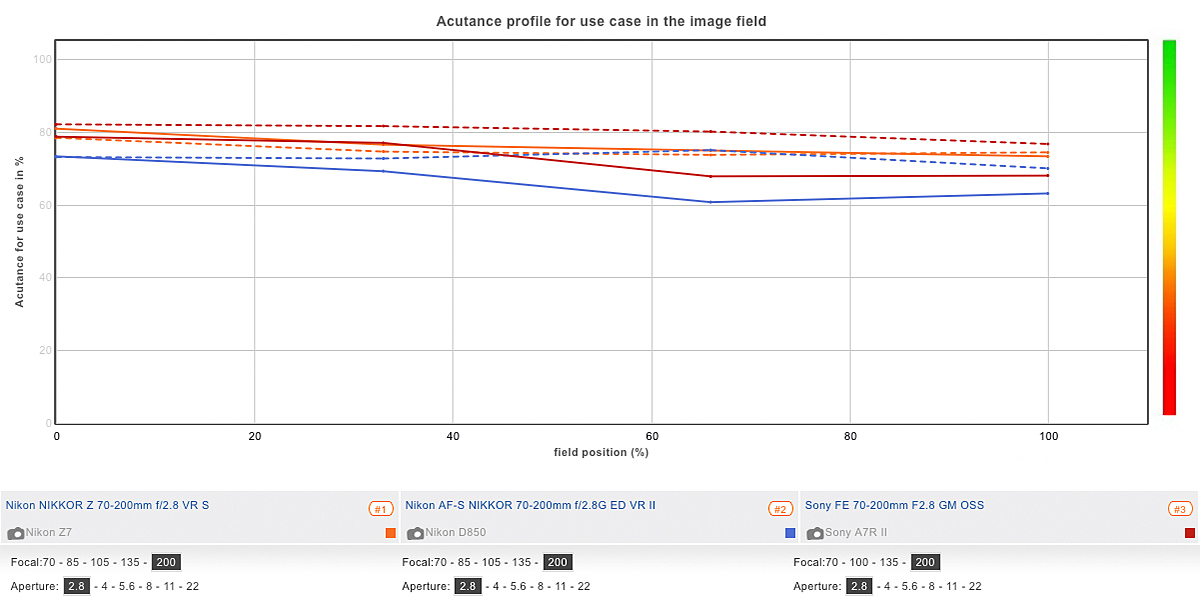
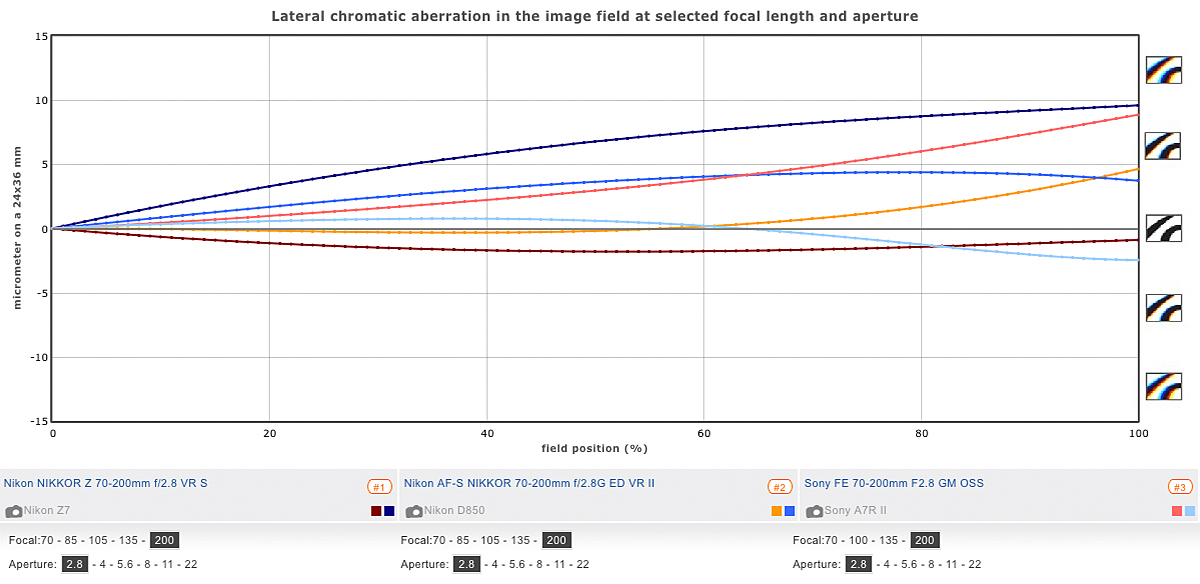
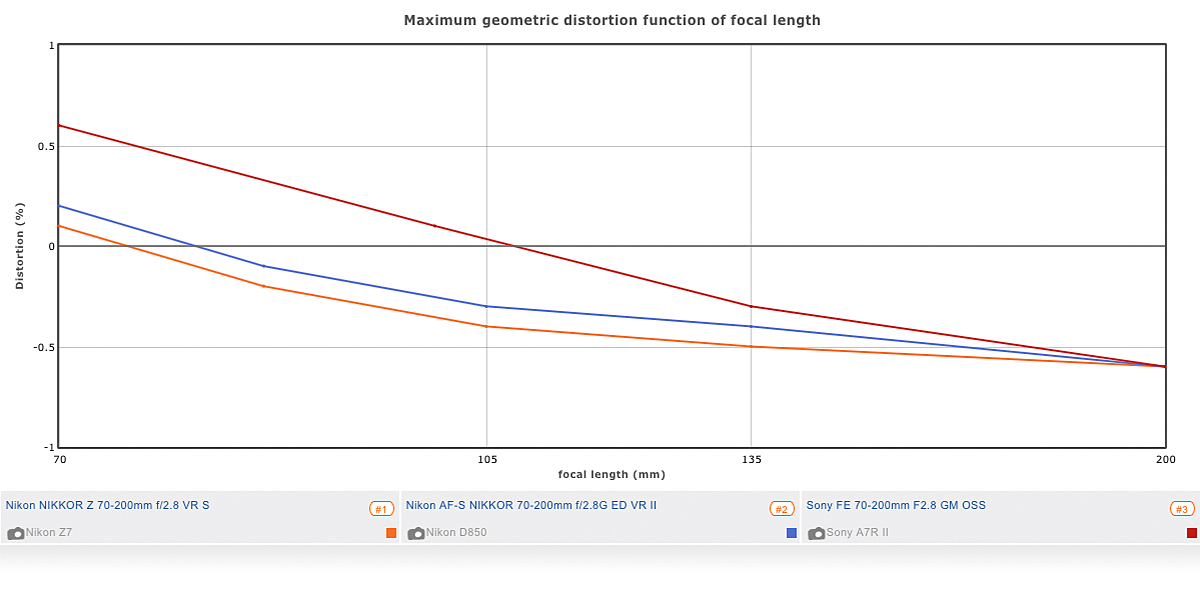
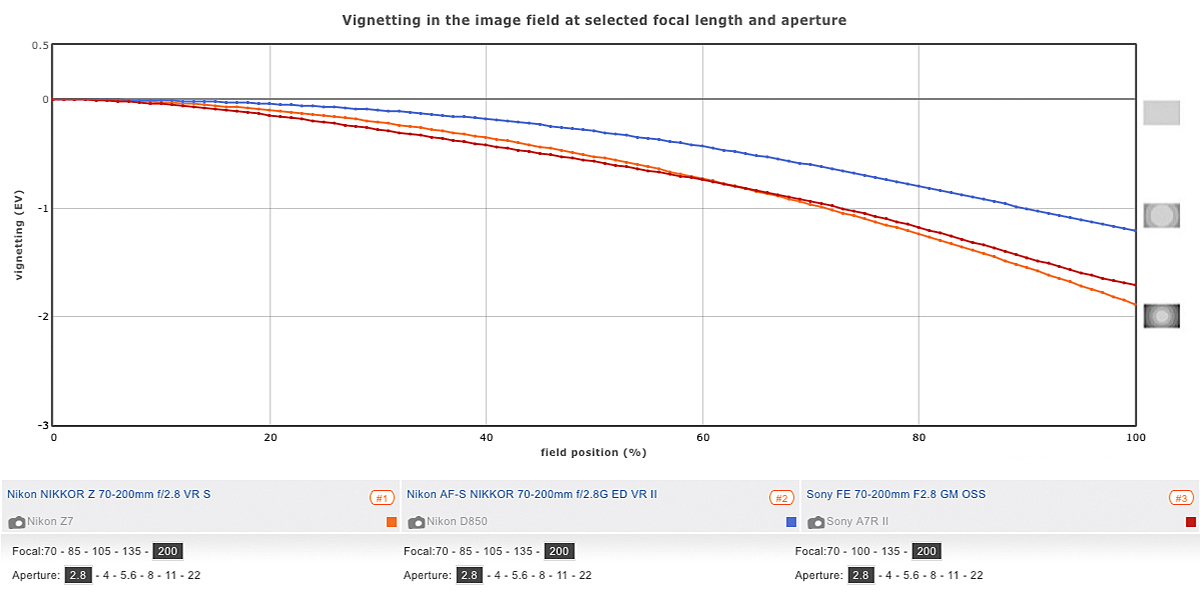
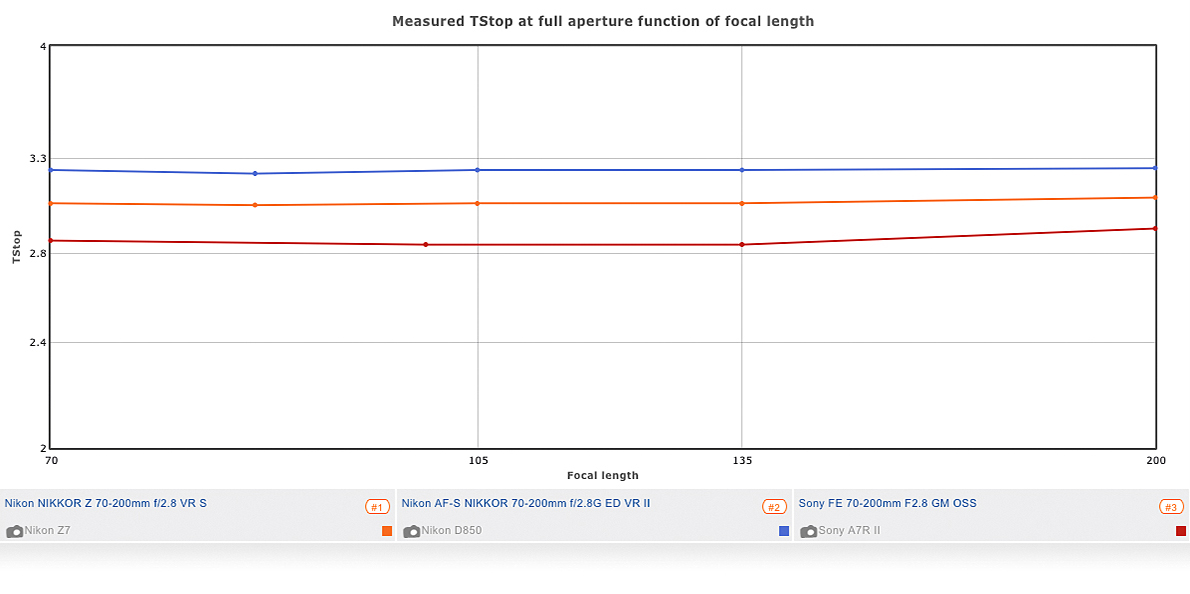
DXOMARK encourages its readers to share comments on the articles. To read or post comments, Disqus cookies are required. Change your Cookies Preferences and read more about our Comment Policy.